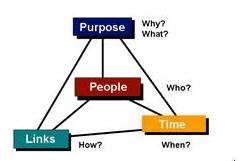Every so often in the past gazillion years, a graduate student comes along, one who's working on a master's or doctorate around virtual/remote/distribution organizations. Some ask for interviews; others want an answer to a specific question. I always say yes--and I hope that other authors do the same.
Here's the most recent with Valeriia Denisova. Born in Saint Petersburg, Russia, she "moved to Finland three years ago to study towards my Bachelor Degree in International Business (BBA) at Tampere University of Applied Sciences." This interview was for her final dissertation, "The Challenges of Virtual Project Management," enabling her to graduate from Tampere, following her spending time as an exchange student at Portsmouth University in the UK.
I post this also as a bit of historiana as we wrote the first edition (cover below) of Virtual Teams nearly 20 years ago. This interview also reflects my biases about the current state-of-the-virtual-art.

You are one of the first people, who recognized the tendency of virtual team management. Could you tell more how and when it happened? Was there any particular reason why you decided to write a ‘’Virtual Teams’’ work on this issue?
Virtual Teams was the fifth book I’d written (with the late Jeffrey Stamps) on distributed, boundary-crossing organizations, the first written after the Web had begun to take hold and Internet penetration had reached most countries in the world. For the first time in history, people had the infrastructure needed to work seamlessly regardless of their physical location.
What can you say about ‘now’ and ‘then’ ? What aspects have massively changed in virtual teams industry over the time?
Work has changed dramatically in the past two decades. Whereas once “knowledge workers” could do very little if they weren’t in the office, now they often wonder why they have to go to the office at all. It’s hard to picture what it was like: the “important” people spent most of their days in offices around the rim of buildings, while the people who reported to them were in vast barns in the middle.
By the 1970s, these rows of desks started to be separated into cubicles. People worked in their “stovepipes,” communicating principally with those in their “departments.” Then, with the rise of the Internet, it became obvious that greater communication, more collaboration, and cross-organizational cooperation could radically improve innovation, creativity, productivity, and implementation. Very quickly, the walls literally started to come down and, with them, cross-boundary work became the norm. Once that began, geography became less the definer of co-workers than purpose, which brought disparate people together regardless of who they were working for.
Was it hard for traditional workers to switch to distant work and accept it?
As with any innovation, some people took quickly to the new way; others resisted. The common wisdom is the familiar one: about 20% of people will always cling to the old way, while 80% rapidly adapt. With a new generation coming along that never knew life without the global mesh, the percentage of resisters will shrink ever more rapidly and eventually become a negligible number.
How does the management of virtual teams differs from traditional ones?
Good managers are simply that: good. One has to pay very close attention to people on their virtual teams lest they feel they’re being ignored or not encouraged to do their very best work.
Some writers and researchers have gone to great lengths to prove that virtual team management is different from in-person management. I’m not one of them.
While there are some peculiar aspects to managing people from afar (being more intentional about contact, for example, since there is no cafeteria for bumping into people), the principles are not all that different from good management in general. Pay attention, be kind, be encouraging, continuously refer to purpose, use multiple forms of communication, reward people for good work, recognize excellent teamwork, lavish people with meaningful praise when they far exceed expectations, continuously examine your own behavior, freely admit mistakes, learn how to apologize in a genuine way, and continuously educate yourself on cultural differences.
What are the main difficulties and challenges of running virtual projects nowadays? How does NetAge help to manage them?
The biggest difficulties and challenges are the same that they’ve always been: lack of clear purpose; inadequate methods—or attention to—maintaining good communication; lack of familiarity and camaraderie among team members; and insensitivity to cultural differences. We have more than enough technology and still lack a good deal of humanity. NetAge developed methods and tools for applying these simple ideas.
Do virtual team principles ‘people, purpose, links’ still remain the same nowadays or, in your opinion, we can add anything more to this concept?

Nope. It’s the same model and we have the same problems. Each aspect of the model has great depth and the more we understand what it means to recognize and honor people in their fullness, the greater the connections among the people. The more we appreciate the purpose and explore its implications, the greater the work people do. The more we expand and nurture our links, the fuller the web of creativity and ingenuity becomes.
According to my survey results, virtual managers do not use intranets anymore. How are the communication sources (‘links’) changed in general?
The technology has changed completely. Some companies and organizations still do have internal webs of communication but the elegance of the expansion of the Internet, the development of cloud computing, and the move to mobile have all radically impacted the openness of connectivity.
This has brought about a paradox: a greater emphasis on security and a loosening of fear that people will “go online” while at work. Who hasn’t? It used to be that companies—and some still do—ban going onto social networks via the corporate network. People just move to using their phones. It can’t be controlled—mainly for the better but we also have too many grisly examples of the new global connectivity being used for the-so-much-horrifically-worse.
What are the main ways of virtual trust and motivation establishment?
We wrote extensively about this in our books. Trust is established by deepening social capital, which results from personal ties, dependability, and generosity. Motivation comes from recognition and challenge, i.e. set high goals for people and then reward them in ways that are meaningful to them, both publicly and privately.
May I use this document in my dissertation?
Yes, of course. Please send me a copy and best of luck! In return, may I use this as a blog post? If so, please send a short bio so that I can credit you with the questions. Where are you situated and at which university are you studying?

